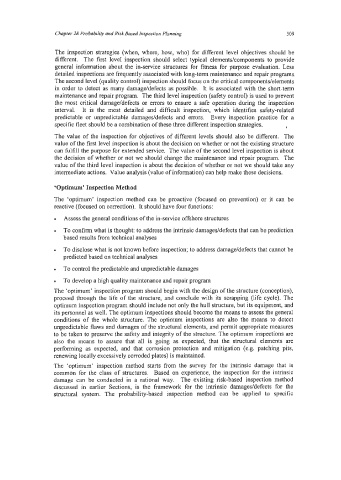Page 533 - Marine Structural Design
P. 533
Chapter 28 Probability and Risk Based Inspection Planning 509
The inspection strategies (when, where, how, who) for different level objectives should be
different. The first level inspection should select typical elements/components to provide
general information about the in-service structures for fitness for purpose evaluation. Less
detailed inspections are frequently associated with long-term maintenance and repair programs.
The second level (quality control) inspection should focus on the critical components/elements
in order to detect as many damage/defects as possible. It is associated with the short-term
maintenance and repair program. The third level inspection (safety control) is used to prevent
the most critical damage/defects or errors to ensure a safe operation during the inspection
interval. It is the most detailed and difficult inspection, which identifies safety-related
predictable or unpredictable damageddefects and errors. Every inspection practice for a
specific fleet should be a combination of these three different inspection strategies. *
The value of the inspection for objectives of different levels should also be different. The
value of the first level inspection is about the decision on whether or not the existing structure
can fulfill the purpose for extended service. The value of the second level inspection is about
the decision of whether or not we should change the maintenance and repair program. The
value of the third level inspection is about the decision of whether or not we should take any
intermediate actions. Value analysis (value of information) can help make these decisions.
‘Optimum’ Inspection Method
The ‘optimum’ inspection method can be proactive (focused on prevention) or it can be
reactive (focused on correction). It should have four functions:
Assess the general conditions of the in-service offshore structures
To confirm what is thought: to address the intrinsic damagesfdefects that can be prediction
based results from technical analyses
To disclose what is not known before inspection; to address damage/defects that cannot be
predicted based on technical analyses
To control the predictable and unpredictable damages
To develop a high quality maintenance and repair program
The ‘optimum’ inspection program should begin with the design of the structure (conception),
proceed through the life of the structure, and conclude with its scrapping (life cycle). The
optimum inspection program should include not only the hull structure, but its equipment, and
its personnel as well. The optimum inspections should become the means to assess the general
conditions of the whole structure. The optimum inspections are also the means to detect
unpredictable flaws and damages of the structural elements, and permit appropriate measures
to be taken to preserve the safety and integrity of the structure. The optimum inspections are
also the means to assure that all is going as expected, that the structural elements are
performing as expected, and that corrosion protection and mitigation (e.g. patching pits,
renewing locally excessively corroded plates) is maintained.
The ‘optimum’ inspection method starts from the survey for the intrinsic damage that is
common for the class of structures. Based on experience, the inspection for the intrinsic
damage can be conducted in a rational way. The existing risk-based inspection method
discussed in earlier Sections, is the framework for the intrinsic damageddefects for the
structural system. The probability-based inspection method can be applied to specific

